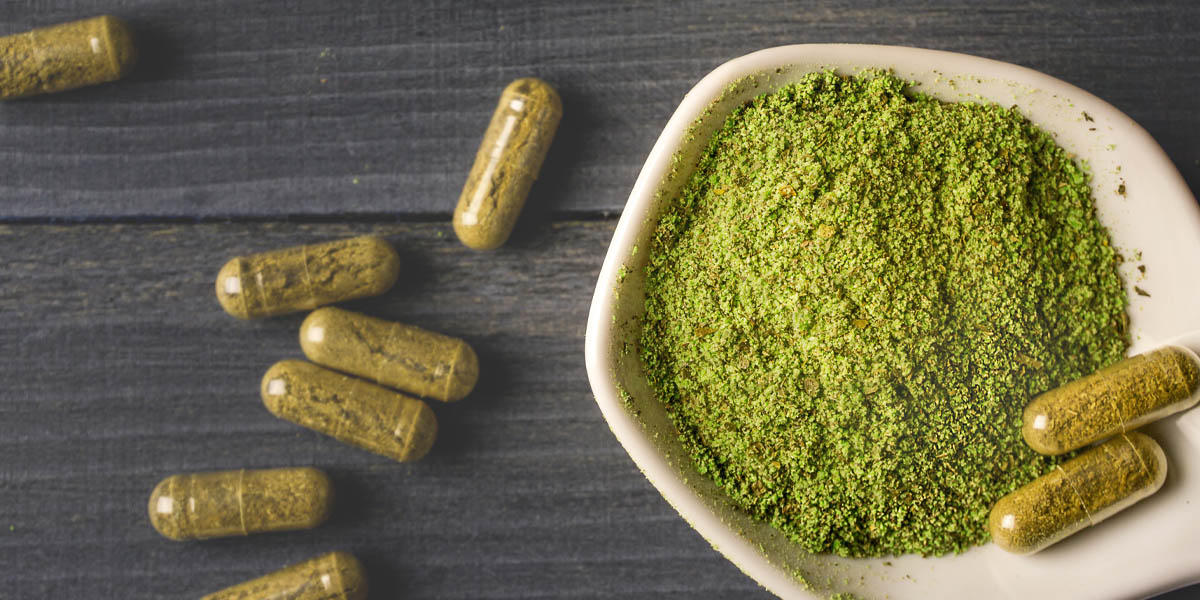Kratom, an herbal medicine, comes from the Mitragyna speciosa tree. In Southeast Asia where it’s from, it’s traditionally used for its pain-relieving and stimulant effects. But the drug is becoming increasingly popular in the U.S., with kratom bars and cafes popping up in several states. And this is cause for concern among addiction treatment providers, as we’re seeing more and more clients coming to us for kratom addiction.
Because kratom is relatively new to the Western world, research and treatment methods are lagging behind the drastic increase in addiction cases. “The prevalence of kratom use has drastically increased worldwide, raising concerns among healthcare providers, particularly regarding the availability of efficacious treatment options for kratom dependence,” says Mohammad Farris Iman Leong Bin Abdullah of the Advanced Medical and Dental Institute at Universiti Sains Malaysia.
Let’s learn more about kratom’s effects and addiction potential, as well as options for treatment if you’re dependent.
Desirable Effects of Kratom
Interestingly, kratom has both stimulant and sedative effects. Which effect is more pronounced depends on the dose you take. Most people take kratom to increase their feelings of the following:
- Relaxation
- Social confidence
- Elevated mood
- Wakefulness
- Pleasure
- Pain relief
Our former client Brad* recalls how kratom first made him feel:
“Kratom is an interesting substance. Its main property is euphoria, and through that, your body recognizes it as an opiate. You start feeling good. You feel loose. It could be the end of the day, as you’re transitioning from work into however you spend your evening. It could be because you’re in pain, or because you just enjoy the feeling. I felt it in my body. It felt good. I was able to talk freely, and I used it as a conversational tool.”
What Are the Negative Side Effects of Kratom?
Kratom use also comes with a host of unwanted outcomes, the most noticeable of which is usually nausea. Other side effects of kratom include:
- Drowsiness
- Itchiness
- Dry mouth
- Constipation
- Perspiration
- Decreased appetite
Excessive doses of kratom can even cause psychosis.
Kratom is also highly addictive, and can cause withdrawals that mirror those of opioid addiction. These include restlessness, frustration, depression, muscle pain and spasms, fever and insomnia.
Despite What You’ve Heard, Kratom is Addictive
The first study to systematically measure kratom dependence, cravings and withdrawals took place in Malaysia in 2014. The study concluded that “regular Kratom use is associated with drug dependency, development of withdrawal symptoms, and craving.” It found that over half of the participants who used kratom regularly for over six months “developed severe Kratom dependence problems,” while “45% showed a moderate Kratom dependence.”
Our former client Katie* recalls how her addiction developed:
“My kratom addiction lasted for at least 3 years. I was such a recluse and couldn’t take care of myself anymore. I started using it because I was really unhappy in my life. Using kratom was a way to feel happy whilst doing something that made me deeply unhappy. That worked at first. It gave me the euphoria and buzz that I needed to accomplish those things: to get up, go to school, come home and do my homework, see friends. It allowed me to be comfortable in social settings.
“But the more I relied on it, the more it took over my life. I then became incapable of doing any of those things without that drug. And then I became capable of doing those things, period. Because you lose your agency when you give your power over to this drug. You can’t function properly without it. Every morning I didn’t get out of bed until I had kratom. Throughout the day, I would have to use it. Eventually, I just became dysfunctional and was unable to even attend school. All I could really worry about was getting my fix.”
Self-medicating Mental and Emotional Pain
Using substances (or behaviors) as a way to self-soothe the deep discomfort inherent in life is a very common path to addiction. (For more on this, see our article on self-medicating depression with opioids.) And kratom is no exception. Here, Brad remembers how it offered welcome relief from the multiple forms of pain he felt:
“I was in emotional pain, suffering from insomnia and feeling a little blue in life. Kratom knocked out all three things at once: emotional, physical and psychological pain. Kratom was numbing my pain in such a proficient way that I wasn’t dealing with any of the issues that were coming up in my life.”
But eventually, those who choose to check out of pain with substances find this relief to be short-lived.
“I was just suppressing them through kratom. And little by little, my depression and anxiety got worse. My relationships got poorer. And that’s because every day, anytime life throws you a curveball, you have that kratom and you don’t have to deal with it. But then you wake up the next day that stress and tension is even worse. And the next day, it’s worse. It just snowballs to a point where you know that this substance has control over you.”
Is Kratom an Opioid?
Kratom isn’t related to the poppy plant, but its effects are very similar to those of opioids. So much so, in fact, that “[Kratom] has been labeled as an atypical opioid with significant narcotic-like properties, capable of inducing kratom dependence among those who misuse or abuse it,” according to the National Center for Biotechnology Information.
This is because kratom works by affecting your brain’s opioid receptors. “The psychoactive alkaloids of kratom, such as mitragynine (MG) and 7-hydroxymitragynine (7-HMG), act as partial mu-opioid agonists and induce kratom dependence,” explains Bin Abdullah. “As a result, regular kratom use leads to withdrawal symptoms on abstinence, along with craving, tolerance, and cross-tolerance to morphine.”
Katie describes how people who use kratom as an opioid alternative can quickly find themselves in a world of hurt:
“My story starts when I was in high school and I had chronic neck and back pain. I was prescribed opioid medication for that pain, which I eventually became addicted to. That lasted for many years until doctors stopped prescribing me those medications. I did a lot of doctor shopping and eventually, it just went dry. I couldn’t find them anywhere. So I had to find something to substitute for my addiction. When a friend introduced me to kratom I thought, ‘Oh, this is great.’ I had no idea what I was getting into.
“I substituted it for OxyContin and Percocet, and it worked.”
“Kratom is a plant, and it’s sold as a powder or a liquid in a rather condensed form. So while it’s a natural product, the way that it’s sold in apothecaries and head shops and online is not natural. You’re getting a really condensed product. I substituted it for OxyContin and Percocet, and it worked. It’s an extremely intense high, because it’s not only a downer like you would get with heroin. You get a very similar high to what I experienced with OxyContin and what I’ve been told heroin is like.”
Kratom is often touted as safe, natural alternative to opioids. Because of this, many people use it as a way to manage opioid withdrawals. But to do this is to severely underestimate its addictive potential. “Kratom can be just as dangerous as opioids,” warns Monty Ghosh, MD, addiction specialist at the University of Alberta Hospital in Edmonton. In fact, opioid medications like buprenorphine are now being used to manage kratom withdrawals.
“The most common way to treat kratom disorder is by using medications which we use to treat opioid use disorder like buprenorphine/naloxone,” says Ghosh.
Deceptive Marketing Makes Kratom Seem Problem-free
Even people who consider themselves health-focused and don’t normally drink or do hard drugs may start using kratom because they believe it to be harmless. Many people who lead otherwise healthy lifestyles centered on wellness and spirituality find themselves becoming part of the communities that spring up around kratom “tea houses.”
Brad didn’t identify as a drinker or drug user. But he found himself deep in a kratom addiction before he realized what was happening.
“Spiritually speaking, alcohol is known as a low-frequency drink. But kratom is in no way, shape or form any different. It dims the soul, dims the light in your eyes and your vitality. You just get to a point where you’re broken inside. And the only thing you know that can bring you out is kratom itself.”
He warns: “It’s something that doesn’t come up on drug tests. It flies under the radar. I just want people to know that once you start drinking kratom, you’ll start craving it.”
Holistically Treating Kratom Addiction at The Sanctuary
At The Sanctuary, your path to recovery begins with a call to our admissions coordinator, who can help you assess your situation and determine if you need detox. If so, we’ll refer you to a partnered detox center and/or help you arrange your transition from the detox center of your choice into residential treatment on our Sedona campus. You’ll then be ready to begin your healing journey in the safe and transformational space of our holistic addiction treatment program.
At The Sanctuary, treating addiction holistically means we see you as a person, not a disease. We understand that you have the innate ability to heal, and our program empowers you to bring that forth. We’ll also help you access and heal the root cause of your issue, so you won’t be stalked by the urge to self-medicate after you leave treatment and return to your daily life. Treatment includes a wide selection of modalities, including but not limited to:
- Individual and group psychotherapy
- Daily meditation and yoga
- Energy medicine
- Weekly consultations with an Integrative Medicine doctor
- A customized supplement protocol
- An organic, superfood diet and weekly nutrition classes to teach you about the science behind it
- Life skills coaching and continuing care
- Nature hikes in beautiful Sedona
- Ceremony
- Compassionate community support from staff and program peers
You’ll also have the chance to experience an abundance of healing methods, so you can decide which works best for you. Many of our clients choose to continue growing their practice in a certain healing art after they leave. We aim to provide you with as many opportunities as possible to try something new that just might change your life.
Start Your Journey Today
To learn more about how you can get started on your path to healing and creating the life you want, contact us today.
Dr. Forrest is a licensed Naturopathic Physician specializing in retreat-style holistic medicine, natural detoxification and cleansing, mind/body medicine, and regenerative medicine. Dr. Forrest brings to his work a sense of humility, respect, and compassion that is too often absent in the sterile, rigid world of modern medicine. He is deeply honored and grateful to be continuing this work as part of the community and healing that is taking place at the Sanctuary. [email protected]

